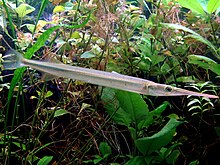Xenentodon cancila
| Xenentodon cancila | |
|---|---|

| |
| Scientific classification | |
| Domain: | Eukaryota |
| Kingdom: | Animalia |
| Phylum: | Chordata |
| Class: | Actinopterygii |
| Order: | Beloniformes |
| Family: | Belonidae |
| Genus: | Xenentodon |
| Species: | X. cancila
|
| Binomial name | |
| Xenentodon cancila (F. Hamilton, 1822)
| |
| Synonyms | |
| |
Xenentodon cancila, the freshwater garfish, is a species of needlefish found in freshwater and brackish habitats in South and Southeast Asia.[2]
Common names
[edit]
As a reasonably popular aquarium fish, Xenentodon cancila has been traded under a variety of common names, including needlefish,[3] silver needlefish,[4] Asian freshwater needlefish,[3] needlenose halfbeak,[5] freshwater gar,[5] needlenose gar and numerous others. While belonging to the same family as the marine needlefish known in Europe as gar or garpike, Belone belone,[6] these fish are much more distantly related to other fishes sometimes called gars (such as the North American gars and South American pike characins).[5] In Assam it is locally known as Kokila. It is known as "Yonna (යොන්නා) or Habarali (හබරලි)" in Sri Lanka.
Distribution
[edit]The freshwater garfish is widely distributed across South and Southeast Asia from India and Sri Lanka to the Malaysian Peninsula.[4]
Morphology
[edit]In common with other needlefish, this species has an elongate body with long, beak-like jaws filled with teeth.[6] The dorsal and anal fins are positioned far back along the body close to the tail.[6] The body is silvery-green, darker above and lighter below with a dark band running horizontally along the flank.[2] Slight sexual dimorphism exists, the male fish often having anal and dorsal fins with a black edge.[4][6] It reaches a length of 40 cm (16 in).[2]
Diet
[edit]While aquarium books tend to describe this fish as a predator that eats animals such as fish and frogs, its natural diet appears to consist almost entirely of crustaceans.[4]
Reproduction
[edit]This species is oviparous.[4] In aquaria at least, spawning takes place in the morning, with small numbers of eggs being deposited among plants.[4] The eggs are about 3.5 mm (0.14 in) in diameter and are attached to plant leaves with sticky threads about 20 mm (0.79 in).[4] The eggs take ten days to hatch, at which point the fry are almost 12 mm (0.47 in) long.[4] At this point they will eat small live foods including week-old labyrinth fish.[4]
Human significance
[edit]Freshwater needlefish support minor fisheries and are also traded as aquarium fish.[2]
In the aquarium
[edit]The freshwater needlefish is one of several of needlefish species kept in public and home aquaria.[6] It has been kept by European aquarists since 1910,[6] and was first bred in captivity at the Biological Station Wilhelminenberg, Austria in 1963.[4] Xenentodon cancila is generally considered quite a difficult species to maintain because of its large size, nervous behaviour, and preference for live foods.[3] Alongside misunderstandings of the natural diet of these fish,[7] there has been confusion over the optimal water conditions required by this species when kept in home aquaria, with the addition of salt to the water often being recommended.[5] These fish do perfectly well in freshwater aquaria.[7]
See also
[edit]References
[edit]- ^ Dey, S.C.; de Alwis Goonatilake, S.; Fernado, M.; Kotagama, O. (2019). "Xenentodon cancila". IUCN Red List of Threatened Species. 2019: e.T166522A60589667. doi:10.2305/IUCN.UK.2019-3.RLTS.T166522A60589667.en. Retrieved 20 November 2021.
- ^ a b c d Froese, Rainer; Pauly, Daniel (eds.). "Xenentodon cancila". FishBase. May 2013 version.
- ^ a b c Monks N: Straight to the point: the Beloniformes. Practical Fishkeeping, October 2005
- ^ a b c d e f g h i j Riehl, R; Baensch, H (1996). Aquarium Atlas (vol. 1). Voyageur Press. ISBN 3-88244-050-3.
- ^ a b c d Monks, Neale, ed. (2006). Brackish Water Fishes. ISBN 0-7938-0564-3.
{{cite book}}:|journal=ignored (help) - ^ a b c d e f Sterba, G (1962). Freshwater Fishes of the World. Vista Books. p. 609pp.
- ^ a b Monks N: Pocket-sized Pikes. Tropical Fish Hobbyist, April 2007

